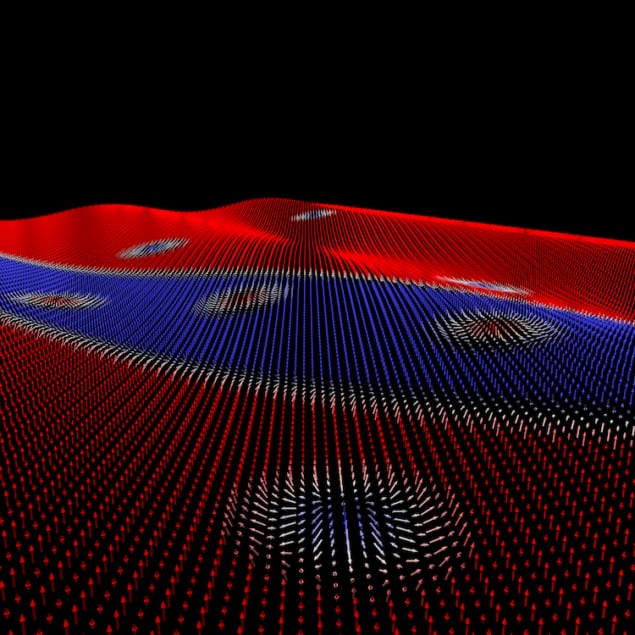
Spintronics devices, which exploit the spin of an electron as well as its charge, could be ideal for use in high-density data storage devices and for next generation information processing. One promising technology involves using magnetic solitons, such as nanoscale domain walls and magnetic skyrmions, which can function as mobile bits, to encode information, and then moving these bits using a current in devices known as racetracks. The main challenges here are to make smaller bits and then efficiently move these at high speeds. Until now, researchers mainly focused on ferromagnetic materials to make such bits, but these unfortunately have their limitations for when it comes to how small they can be made and the speed at which they can be moved. Material scientists and physicists in the US and Germany say they have now found a way to overcome this problem by using ferrimagnets instead. This new class of materials allow for order-of-magnitude improvements in speed and size and means that the technology might now be brought to market in a reasonably short timeframe.
“We have succeeded in driving domain wall motion with a speed of 1.3 km/s in ferrimagnetic Pt/Gd44Co56/TaOxfilms using an applied current,” says Geoffrey Beach of the Massachusetts Institute of Technology (MIT), who led this research effort. “We have also found that the material hosts room-temperature-stable skyrmions as small as 10 nm in size.”
Racetrack memory
Racetrack memory is a relatively new technology that involves moving magnetic domain walls or skyrmions along structures like magnetic nanowires using small spin-polarized current pulses. It is radically different to conventional computer hard drives (which use a motor to rotate glass discs on which magnetic bits are stored in a thin film) in that it uses electric currents to move the magnetic domain walls or skyrmions in the nanowire without displacing any atoms at all.
Magnetic domain walls are narrow boundaries between regions in a material in which the magnetic moments point “up” on one side of the wall and “down” on the other. In a racetrack memory, data are stored as a sequence of magnetic domains along a nanowire and individual bits are stored and retrieved by moving the sequence along the nanowire and across magnetic read and write devices.
Skyrmions, for their part, are quasiparticle magnetic spin configurations with a whirling vortex-like structure and could be ideal as storage bits in racetrack memories and logic devices because they can be made much smaller than the magnetic domains used in modern disk drives. Conventional domains require considerable power to flip all of the spins in the domains (to switch a device’s memory state from 1 to 0, for example) but skyrmions require fewer spin flips to switch. Another advantage is that the final spin state is not easily disrupted either, which makes these skyrmion structures more stable than their conventional cousins.
Ferromagnets good, ferrimagnets much better
“The key challenges in realizing such memories today are to make smaller bits and then move them at high speed through the racetrack,” explains Beach. “Until now, most research has focused on ferromagnets for making such bits but these materials do suffer from several fundamental problems. These include stray magnetic fields from individual bits, which in spintronics devices can be a serious impediment because they can perturb the spin states of neighbour bits. These magnetic fields are often the limiting factor in how small and densely packed magnetic bits can be. And while magnetic skyrmions can, in principle, be extremely small and stable, in practice all skyrmions seen at room temperature so far have been very large, due to the fact that the ferromagnetic materials used to make them have large stray fields.
“In magnetic materials, the atomic magnetic moments on each lattice site align with their neighbours,” he continues. “In ferromagnets, neighbouring moments are parallel to one another whereas in antiferromagnets, they are anti-parallel, which leads to the net magnetization cancelling. Since magnetic moments originate from the angular momentum (spin and orbital) of an electron, the total angular momentum of an antiferromagnet is always zero. In this case, we can achieve exceptionally fast domain wall dynamics because reorienting the magnetic moments does not require a change in the net angular momentum.”
The researchers say they realized this behaviour in the lab by using a ferrimagnetic material, which is similar to an antiferromagnet but in which the neighbouring atoms are different (Co and Gd in this case). “In the material we studied we can adjust the temperature such that either the net magnetization is zero, which is known as the magnetic compensation temperature (TM), or such that the net angular momentum is zero, which is known as the angular-momentum compensation temperature (TA),” Beach tells Physics World. “Doing this allows us to directly examine the effect of total angular momentum on the dynamics of the material. We found that when it is zero, we can move magnetic domain walls at more than 1000 m/s just by injecting a small current.
“We can also tune the temperature so that the net magnetization is zero and we engineered our material so that this happens near room temperature. This allows for stable, ultrasmall skyrmions, the likes of which cannot be realized in conventional materials. Before now, cryogenic temperatures and applied magnetic fields of more than 1 Tesla were needed.”
The team, which includes researchers from the Max-Born-Institut in Berlin, the Technische Universität Berlin and Deutsches Elektronen-Synchrotron (DESY) in Hamburg, details its research in Nature Nanotechnology 10.1038/s41565-018-0255-3.



